Kayaking in Desolation Sound was one of my all-time favourite trips! There are many considerations when going on a multi-day kayaking trip. It can be a blast or a terrible trip if proper precautions aren’t taken. Here are eleven tips to ensure you have an amazing trip.
Table of Contents
1. Safety Precautions When Kayaking in Desolation Sound
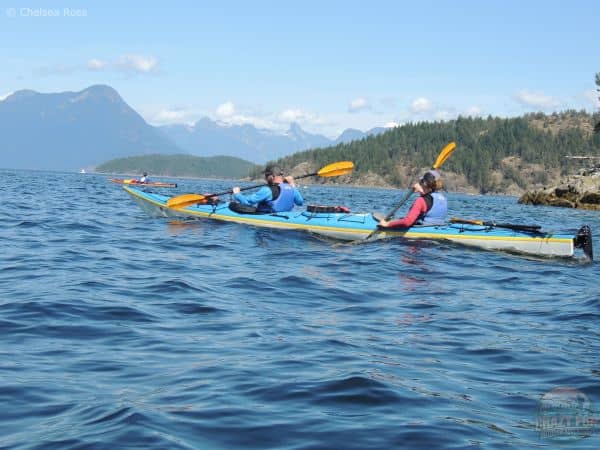
To start off, one of the most important tips is to take your safety seriously. When renting kayaks at Powell River Sea Kayaks in Desolation Sound, be aware of the safety precautions put in place. They are there to ensure that you don’t end up out of your element. To rent kayaks overnight, one person from a group of five will be required to have taken a lesson with a focus on wet exits, self and assisted rescues. You’ll be required to sign a rental agreement and a waiver form, stating that they are not liable should something happen to you or your belongings. If your plans change, read their cancellation policy.
Bring Rescue Equipment
Bringing rescue equipment is important in case you end up in trouble. If you’re renting, the following items will be required to bring on your trip. The provided equipment includes a floater for your paddle, a whistle, a throw rope and a kayak hand pump to remove water quickly from your kayak. If you have your own kayaks, it’s strongly advised that you bring rescue equipment with you.
Bring the Right Gear
The water temperature kayaking in Desolation Sound can be extremely cold and requires appropriate equipment in case you fall in. Bring suitable gear for when it’s sunny too.
Equipment for Cold Water
- A rented PFD (life jacket) could be uncomfortable, after many uses. Buying your own, which shapes your body might be a consideration. Don’t bring a rectangular-shaped personal floatation device for kayaking, as it won’t work well for this sport while sitting in a kayak. It tends to ride higher up instead of contouring your body. A MEC Fulcrum Guide PFD offers pockets for an underwater camera and snacks such as granola bars or energy gummies to provide boosts of energy when needed.
- A kayaking skirt covers the kayak where you sit to keep the water out and prevent it from sinking. Your legs will thank you for protecting them from a cold splash of water, potential wind or sunlight.
- A wetsuit allows for added warmth throughout your body. If you fall into the ocean, you’ll have a higher chance of staying warmer for a longer period of time. This could prevent you from going into shock or suffering from hypothermia.
- A paddling top (long-sleeve jacket) offers a windproof and waterproof layer against the elements.
Equipment for Sunny Weather
- A hat, such as a baseball cap can offer protection for your eyes. A brim sun hat can also offer extra protection to your neck and ears. You might consider having one with a neck strap in case of a strong wind.
- Sunglasses help against the sunshine rays reflecting off the water and into your eyes. Make sure to protect yourself against sun blindness.
- A wick-away shirt helps to protect your arms from getting burnt or getting heat exhaustion or even worse, heat stroke. It wicks moisture away from your body when working out to prevent feeling sweaty. It also offers an additional layer of warmth, in case of cold weather.
Navigation
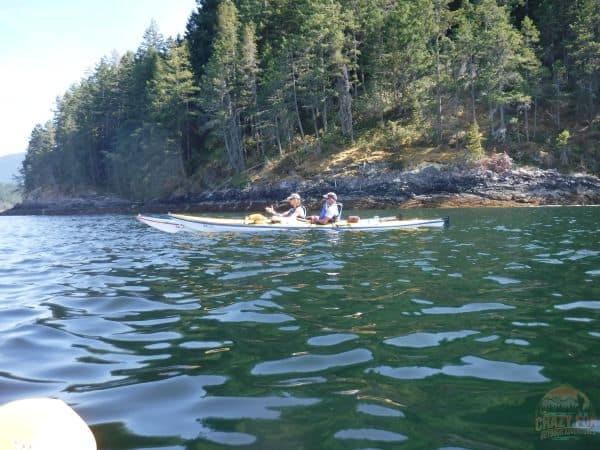
My dad and brother took a moment to evaluate the map to see where we were headed next.

A waterproof map is essential to navigate toward your destination. A paper map will fall apart in minutes once it gets soaked.
2. Practice Kayaking to Feel Confident
It’s important to experience kayaking day trips to develop confidence. The more you feel the movement of the water underneath the kayak as you paddle forward, the more seamless it will make your ocean trip. Experiencing different weather conditions and paddling on lakes will increase your adaptability when kayaking in Desolation Sound.
Endurance Level
Day trips allow personal growth while working on your endurance level. Canoeing might seem like a never-ending pattern of pulling yourself forward focusing on the same muscles over and over while paddling on one side. In comparison kayaking, requires movement on each side of the kayak. Both arms take turns pulling the water backwards with each paddle in the water. It offers the arms a more balanced exercise with all arm muscles moving back and forth. Throughout the multi-day trip, if the motion of kayaking hasn’t been practiced enough, it can get exhausting quickly, resulting in a frustrating and long trip.
Sitting straight up in a kayak can get tiring on your back in a short amount of time. Most people don’t generally sit vertically, as required in a kayak. Day trips allow your back to get used to this upright position.
3. Marine Wildlife

We were fortunate enough to catch sea lions sun tanning on rocks and moss on multiple occasions.
Kayaking in Desolation Sound offers many opportunities to see marine wildlife. I love watching the sea lions on the rocks. The sea lions can be extremely playful. It makes it fun to watch them and guess where you’ll see them next while kayaking on your adventure. You never know when a sea lion will poke its head out for a photo shoot.
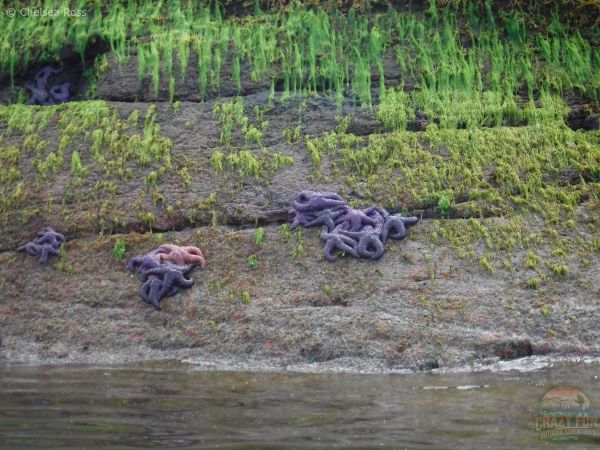
Purple and pink starfish could often be seen hanging to the side of the rock at low tide.
During a clear day without wind and gliding through calm water on the ocean, you can spot starfish in shallow water. Make sure to keep an eye out to see different shapes and sizes.
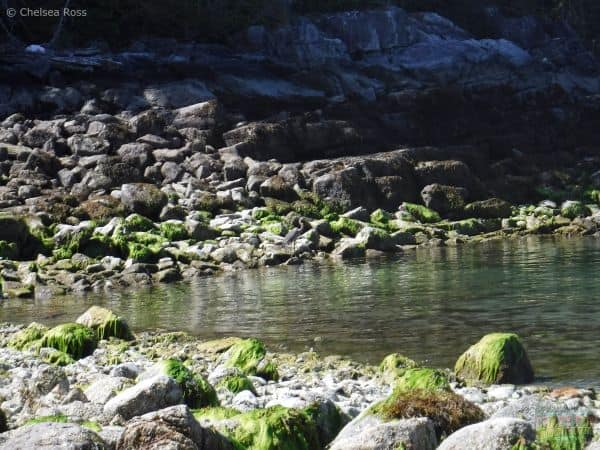
We were lucky to encounter a grey heron on the rocks. He’s in the middle of the picture blending into the background. Grey herons can be found looking for fish in shallow water by the shore. It might be hard to spot them unless you have a keen eye.
Picture Opportunities
Bring an underwater camera for excellent picture opportunities. Better yet, consider bringing a sharper camera that takes better pictures. It won’t be waterproof but will take nicer pictures. Many of the pictures taken on this trip were taken with Canon or Nikon cameras. When the wind and water were calm, we took spectacular pictures of the scenery, wildlife and the clear blue ocean. The downside is that there is a risk of possibly damaging the camera if it’s not waterproof. You decide if you’d like to risk it or not. If you’re able to take breathtaking pictures, it creates wonderful memories once the trip is done!
4. Freedom of Kayaking in Desolation Sound
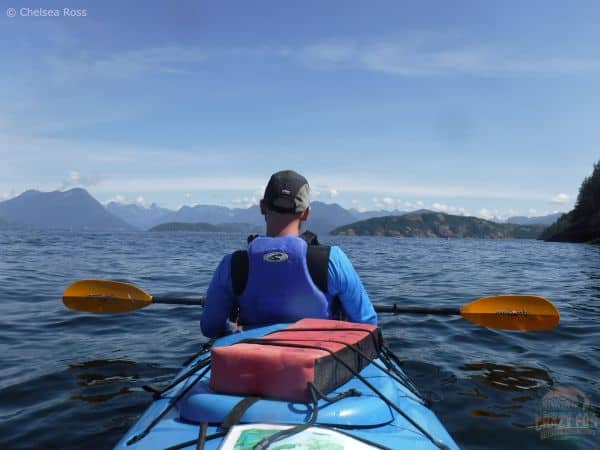
Kayaking offers an exuberant amount of energy and freedom! Open water permits you to take any direction you desire. The control is in your hands, unlike a trail where you’re following a leader. The best part is that you and your family members end up at the same destination. The group can go at different speeds and break independently, while maintaining a close eye on each other, of course. You have the liberty to search for marine wildlife and enjoy the scenery while being immersed in the experience. The trip can be enjoyed without being rushed (unless you’re in a time crunch). Looking ahead to the unexplored territory is so exciting! There are so many places to explore. The freedom promotes curiosity and a yearning to learn more about the region where you are kayaking.
5. Beautiful Campsites
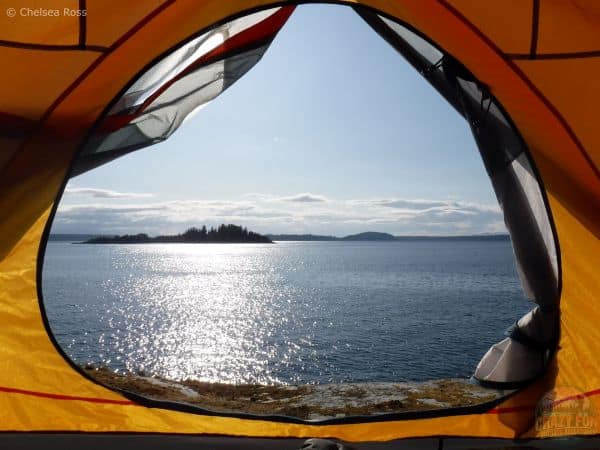
This was the view from our tent at the first campsite at Copeland Island. The tents are set on designated elevated wooden platforms on bedrock. Being so high up showcased beautiful views from the tent when going to bed and waking up the next morning.

The view was spectacular at all three campsites we picked. The tenting area is up high from where we ate. We had different-sized dry bags to put all our stuff in.
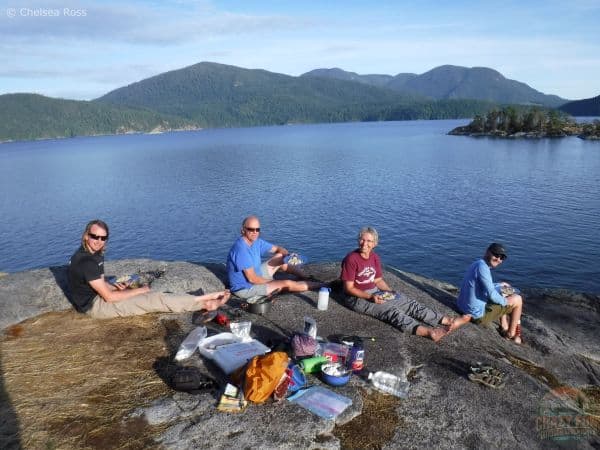
My family and Kris eating supper on Curme Island. We experienced gorgeous views while appreciating living in the moment. How often do you get a view like this? There is no better feeling than being in the middle of nowhere with family to enjoy each other’s company. It’s magical.
6. Carrying Gear in a Kayak

There is a lot of appreciation when the kayak does all the work transporting the gear, rather than carrying everything on your back while backpacking the West Coast Trail. The kayak has lovely compartments to store everything. How fantastic! Ensure you have the right equipment to keep everything dry. Dry bags come in different shapes and sizes, from 5L to 55L. Some material is more malleable while others are more rigid and durable; these are less likely to tear if they get snagged on something. Kayak compartments are different sizes as well. Bring a variety of bag sizes. Many 20L bags will fit together in one compartment, compared to only one larger 35L bag fitting in one cavity. It‘s easier to fit smaller bags in a nook and cranny.
As there are a limited number of chambers to put your gear in, it’s important to only bring the essential food and not overload your kayak. Having the food take up all the space in the kayak without leaving room for your sleeping gear, clothes, etc. wouldn’t be wise. Don’t overpack your clothing either. Only bring two sets of clothing. One set is to wear kayaking and a change of clothes is required for hanging around camp relaxing and sleeping.
Tip: Always bring a fleece. It’s important to have a warm jacket to wear when you’re done kayaking to keep warm. After a long day of kayaking, you’ll cool off quickly and require warm clothing.
7. Family Connection While Kayaking in Desolation Sound
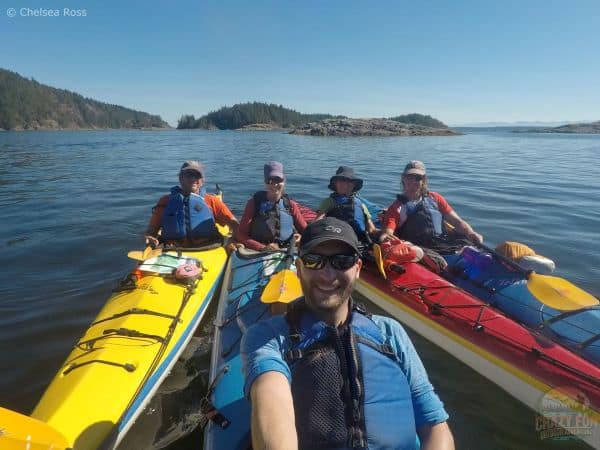
This trip allowed for lots of quality time with family in and out of the kayaks. Going with one or multiple experienced family members can help make the trip more enjoyable. My dad and brother were the navigators on the trip, testing the waters and the winds to figure out our next course of action. We relied on them to help us make it to our destination. It also helped to build trust as we progressed through the trip. They did an excellent job getting us to where we needed to go. It was awesome to have someone to help us troubleshoot with navigation, weather conditions, tidal tables, and ocean currents.
The trip allowed for uninterrupted quality time together as data and WIFI is not accessible in that area. Connections happened through conversations, card games, walks on the beach, cooking meals together, swimming, and plain old fun and jokes to keep each other entertained.
When deciding who gets to join your trip, make sure you’ve gone kayaking with them previously. It’s an excellent idea to do a practice run beforehand to make sure you’re all on the same page. Getting together hiking is one thing but going on a multi-day kayaking trip is completely different. It’s important to figure out who is experienced (or has taken a lesson) to guide the trip.
8. Take a Day to Relax or Explore
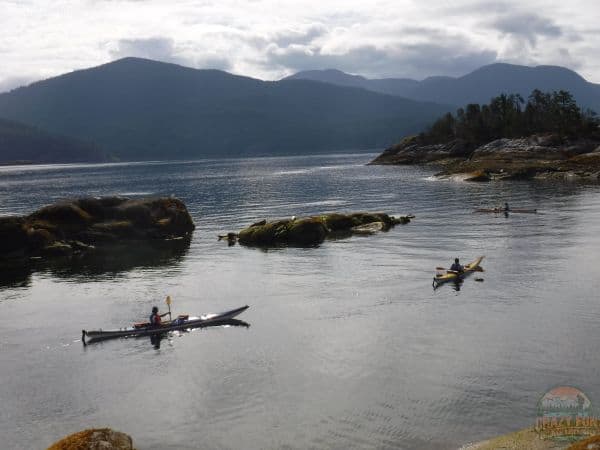
My parents and brother decided to go explore on their day off, with no extra equipment with them. Bringing the bare minimum such as lunch, water, snacks and safety gear (you always bring that with you), will allow for a lighter kayak and an enjoyable day. Exploring islands nearby and checking out what there is to see is a fantastic start. Sea lions, starfish and birds soaring high above might be seen on your kayaking day trip. The additional day adds enjoyment to explore new areas not seen before. It’s peaceful with no rush to get anywhere with no particular destination in mind. The awesome thing about an exploring day is that you get to do what you want when you want.
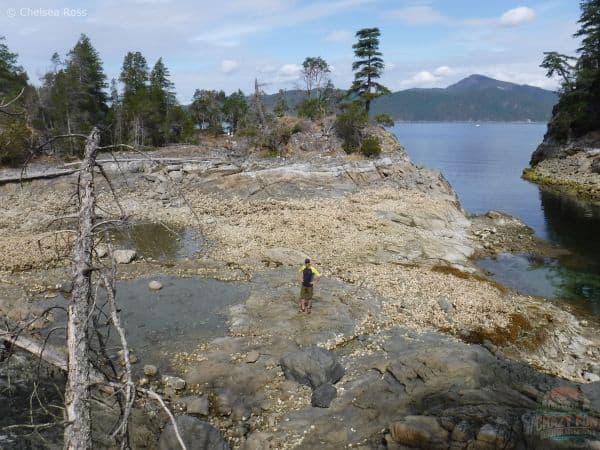
We chose to stay back at camp and relax. Kris, not used to extensive paddling in one day had no interest in going out to explore on his day off, when the next day, he’d be back at it, paddling his way back. At low tide, it’s possible to walk around looking at seashells and cross over to other islands to explore on land.
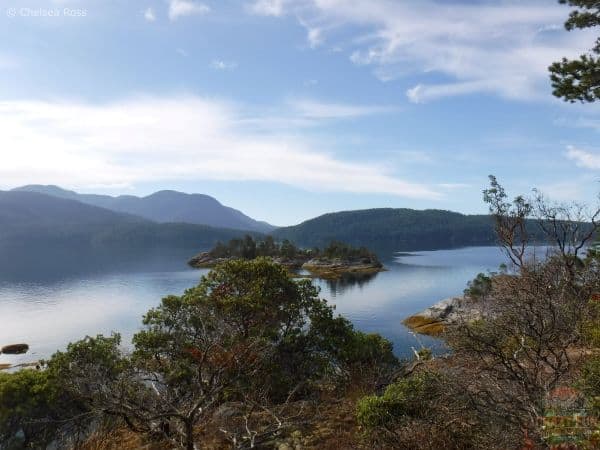
The water is gorgeous for swimming, spending twenty or thirty minutes in it at a time. Some people might consider it cold but it can be so refreshing. Sea lions popped their heads up around the island if you watched for them.
A group with a guide showed up on our island for lunch and they decided to stay on the adjacent island for the night. Groups do come by every once in a while, but for the most part, we found it quiet.
9. Double Kayaks
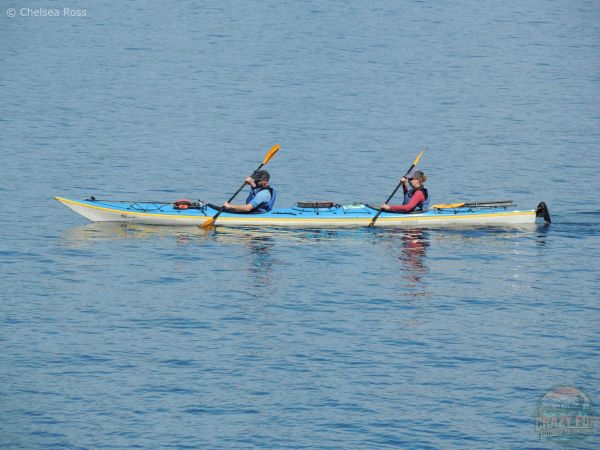
Kayaking in a double kayak is a fantastic way to encourage a family member to kayak. A person can take breaks when tired while the partner keeps paddling towards the destination. Working in sync can make your family members see how fast they can go. A steady motion can create a good rhythm.
Upper Arm Workout Kayaking in Desolation Sound
If your partner or child isn’t as strong with upper body strength, this is a way to make it feasible. Although, it might seem like you’re going twice as fast in a double kayak, remember that you’re carrying more weight than the single kayak. Your arms will feel the push and pull after a full day of kayaking. It’s an intense upper arm workout but wonderful to have a break from walking while backpacking for multiple days.
To practice your upper body strength, consider going to Lake Isle Kayaking Adventures: Four Directions to Consider when Kayaking. Your arms will thank you once you get them prepared for an extended trip.
10. Solar Eclipse Kayaking in Desolation Sound
Solar eclipses are rare but sometimes possible to experience while you are kayaking, as we did. If you end up in that situation, be aware of the solar eclipse calendar so that you know if you might get caught in it mid-day. Plan your day accordingly and cross the channel by the expected eclipse time. Paddling closer to the shore is safer. We experienced the solar eclipse while paddling. Everything turned very dark around us on the ocean, which made it spooky, especially being on open water. We were in semi-darkness for only about five minutes but enough to want daylight back again to see our surroundings. Thankfully, we were done crossing the channel and close to shore when we experienced the solar eclipse. It can be disorientating having never experienced a solar eclipse while being on an ocean.
11. Crossing Large Channels
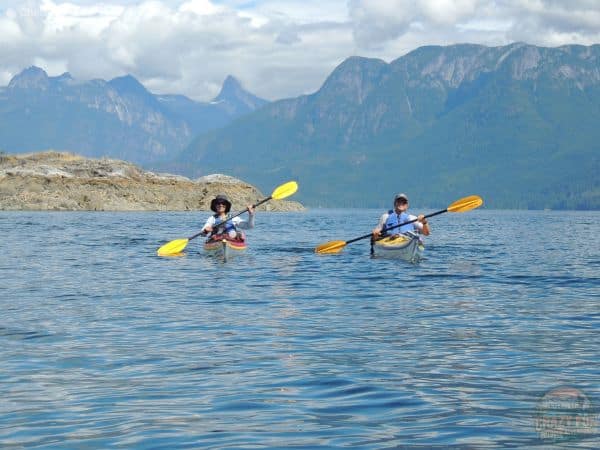
When crossing large channels, travel with three or more kayaks beside each other with ample spacing between them. By doing so, it makes the group appear as a large boat for oncoming cruise ships or other boats headed in your direction.
Tip: Don’t stop while you’re crossing a channel. Winds can change suddenly and there is a higher chance of getting hit by a watercraft if you are stationary and you end up in the channel for longer than necessary. Crossing a large channel is sometimes required to reach your destination but should be done efficiently. It’s not a place to take breaks and enjoy the scenery. Instead, it’s a place to get the job accomplished.
Final Thoughts
These are suggestions to help you make the best of your trip kayaking in Desolation Sound. Many different challenges can arise but if you follow the eleven tips mentioned above, you’ll be in great shape to have an excellent trip! Make the best of your adventure, rain or shine. Appreciate the little things such as sea lions popping their heads up around you or seeing starfish in the water below you. If you choose to go on a family adventure, enjoy everyone’s company, free of technology and go back to the basics of having conversations. Connecting with your family members is what a multi-day trip is all about!
Additional Links
- How to Get Better at Kayaking?
- How to Have an Awesome Day Kayaking with Dad
- Sporty Majestic Resort Kayaking
- 15 Awesome Kayaking Gifts for Moms
- 6 Easy Snack Ideas for Kayaking Trips
Resources to Book Your Trip to Desolation Sound
- Book your flights with Expedia
- Book your hotel through Booking.com or Hotels.com
- Book your vacation rental through Vrbo
- Book your experiences through GetYourGuide
Pin It:
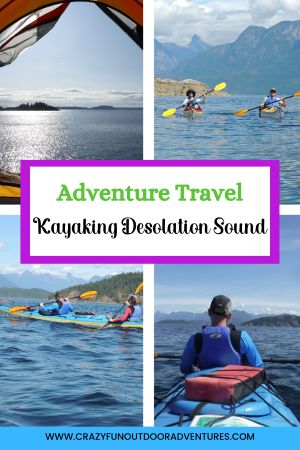
This post may contain affiliate links. If you purchase through my links, I might receive a small commission, at no additional cost to you. I only recommend companies and products that I’ve used and tested myself. If you’d like to support me, I’d greatly appreciate it! It will help pay for the costs to run my website.

Leave a Reply